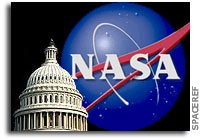AIP FYI: FY 2016 House Appropriations Bill: NASA

The full House Appropriations Committee met Wednesday and approved by voice vote the FY 2016 Commerce, Justice, Science Appropriations Bill. Under this bill, NASA funding would increase $518.9 million or 2.9 percent in the new fiscal year.
Accompanying this bill is a committee report that explains the $51.4 billion bill “prioritizes funding for Federal law enforcement, national security, and the National Aeronautics and Space Administration (NASA) while freezing, reducing, or eliminating funding for non-critical activities.”
The committee report has a ten page section regarding NASA that starts on page 53; a funding table is on page 104. Of note is introductory language stating “The Committee directs that the priorities as outlined in the decadal surveys for planetary science, earth science, astrophysics, and heliophysics shall drive NASA mission priorities.” In this section there is also language regarding General Accountability Office assessments of large-scale projects; cost, schedule, and performance goals; and other administrative and management matters. Funding is as follows:
NASA
The FY 2015 appropriation was $18,010.2 million
The FY 2016 request is $18,529.1 million, an increase of $518.9 million or 2.9 percent
The House bill provides $18,529.1 million, an increase of $518.9 million or 2.9 percent
Within this budget are the following selected accounts:
Science
The FY 2015 appropriation was $5,244.7 million
The FY 2016 request is $5,288.6 million, an increase of $43.9 million or 0.8 percent
The House bill provides $5,237.5 million, a decrease of $7.2 million or 0.1 percent
Within the Science Directorate are the following programs (current year appropriation not provided in committee report):
Astrophysics
The FY 2016 request is $709.1 million
The House bill provides $735.6 million
The report states: “The Committee recognizes that the Kepler Mission has revolutionized the pace of planet finding, suggesting that the Milky Way Galaxy is teeming with exoplanets. As a result, the Committee recommends that NASA accelerate its exoplanet program goals to discover, characterize, and eventually identify exoplanet candidates that could harbor life.”
Earth Science Research
The FY 2016 request is $1,947.4 million
The House bill provides $1,682.9 million
The report states: “This amount maintains most programs at the fiscal year 2015 operating level and adopts reductions proposed in the budget request for the Soil Moisture Active and Passive satellite; the Global Precipitation Measurement Project; and GRACE follow-on activities. No funds are provided for the Thermal-Infrared Free-Flyer. Instead, $32,900,000 is for Landsat-9 in accordance with direction on the Landsat program. . . . “
Heliophysics
The FY 2016 request is $651.0 million
The House bill provides $642.0 million
James Webb Space Telescope
The FY 2016 request is $620.0 million
The House bill provides $620.0 million
The report states: “According to the most recent GAO report, JWST officials note that the project remains within its cost cap and is maintaining its 2018 launch date, but that the programis entering the critical integration stage and issues persist that may impact the overall schedule. NASA shall continue to provide the Committee with quarterly briefings on JWST’s technical status and achievement of program milestones, and budget and schedule performance.”
Planetary Science
The FY 2016 request is $1,361.2 million
The House bill provides $1,557.0 million
The report states: “NASA’s request for Planetary Science once again proposes a decrease below appropriated levels and would have a negative impact on both planned and existing missions.”
The report also discusses explorations goals – including the asteroid redirect mission, Mars exploration, an Ocean Worlds Exploration Program centering on Jupiter’s Europa, and Plutonium-238 production.
The report also has the committee’s recommendation regarding the Stratospheric Observatory for Infrared Astronomy.
Aeronautics
The FY 2015 appropriation was $651.0 million
The FY 2016 request is $571.4 million, a decrease of $79.6 million or 12.2 percent
The House bill provides $600.0 million, a decrease of $51.0 million or 7.8 percent
Space Technology
The FY 2015 appropriation was $596.0 million
The FY 2016 request is $724.8 million, an increase of $128.8 million or 21.6 percent
The House bill provides $625.0 million, an increase of $29.0 million or 4.9 percent
The report discusses icy planets and nuclear propulsion.
Exploration
The FY 2015 appropriation was $4,356.7 million
The FY 2016 request is $4,505.9 million, an increase of $149.2 million or 3.4 percent
The House bill provides $4,759.3 million, an increase of $402.6 million or 9.2 percent
The report has sections on human exploration, Space Launch System, Orion, Commercial Crew, and other programs.
Space Operations
The FY 2015 appropriation was $3,827.8 million
The FY 2016 request is $4,003.7 million, an increase of $175.9 million or 4.6 percent
The House bill provides $3,957.3 million, an increase of $129.5 million or 3.4 percent
The report comments on the International Space Station and research, and the 21st Century Space Launch Complex.
Education
The FY 2015 appropriation was $119.0 million
The FY 2016 request is $88.9 million, a decrease of $30.1 million or 25.3 percent
The House bill provides $119.0 million; level funding








